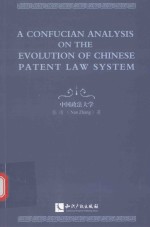

中国专利制度演进论 基于儒学的考察 英文版PDF电子书下载
- 电子书积分:10 积分如何计算积分?
- 作 者:张南著
- 出 版 社:北京:知识产权出版社
- 出版年份:2015
- ISBN:9787513037105
- 页数:246 页
1.Introduction 1
1.1 Clarifications of the Arguments and Contributions 1
1.2 Literature Review 2
1.3 Research Methodology 7
2.A Brief History of Chinese Innovation 8
2.1 Changes of Social Group and the Booming of Patents 8
2.1.1 The New Social Changes Brought About by Industrialisation 8
2.1.2 The British Industrialists and Patents 12
2.1.3 Chinese Industrialists and Patents 14
2.1.3.1 The First Golden Time 14
2.1.3.2 The Second Golden Time 18
2.1.3.3The Third Golden Time 20
2.2 Industrialism and International Trade 23
2.2.1 What Happened in the Past 23
2.2.2 What Is Happening Now—More Investment Abroad 25
2.2.3 OEM vs.ODM 26
2.2.4 Anti-Monopoly Law System 27
2.2.4.1 Anti-Unfair Competition Law 1993 27
2.2.4.2 Anti-Monopoly Law 2007 and After 28
2.3 The Rise of a Creative Group 33
2.4 Cultural Strategies for Legal Enforcement 34
3.A Consideration of Intellectual Property through a Confucian Exploration 36
3.1 Introduction 36
3.2 The Origin of Chinese civilisation 38
3.3 Confucius 39
3.3.1 Confucius and His Historical Background 39
3.3.2“Four Books and Five Classics” 45
3.3.2.1“Four Books” 45
3.3.2.2“Five Classics” 53
3.3.3 Confucius's Social,Educational and Moral Impact 60
3.3.3.1 His Social Impact 60
3.3.3.2 His Educational Impact 62
3.3.4 His Moral Impact:“Ren”,“Lun”,and“Li” 70
3.3.4.1“Ren” 70
3.3.4.2“Lun” 72
3.3.4.3“Li” 74
3.5 Conclusion 74
4.The Ancient Innovation and Early Chinese Patent Law 76
4.1 Introduction 76
4.2 Examples of Ancient Innovations 76
4.2.1 The Armillary Sphere 76
4.2.2 The Compass 78
4.2.3 The Development of Paper Making 80
4.2.4 Printing 84
4.2.5 Gun Powder 86
4.3 Eady Chinese Patent Law 88
4.3.1 Introduction 88
4.3.2 The Seed of Chinese Patent Law 89
4.3.3 Patent Legislation 1912—1949 91
4.3.4 Patent Legislation 1949—1963 92
4.3.5 Chinese Patent Law 1984 94
5.China's Updates in Patent Law 98
5.1 Introduction 98
5.2 The 1992 Amendment 98
5.3 The 2001 Amendment 99
5.4 The 2009 Amendment 102
5.5 The Entry into Patent Cooperation Treaty(PCT) 104
5.6 International Trainings 106
5.7 Patent Rights 107
5.7.1 Types of Patent Rights 107
5.7.2 Examination on Invention,Utility Model and Design Patents 114
5.7.3 Patent Licences 117
5.7.3.1 The Royalties of DVD6C Group 118
5.7.3.2 Netac—the Firstly Chinese Company Collecting Royalties in the US 119
5.7.3.3 Patent Licensing and the Future Development of Domestic Industry 120
5.7.4 Injunctions 123
5.7.5 Preservation of Evidence 127
5.7.6 Patent Infringement Actions 129
5.7.7 Non-infringement Actions 133
5.7.7.1 Non-infringement Actions on the Patented Process 133
5.7.7.2 Prior Art Defence 134
5.7.7.3 The Doctrine of First Sale 137
5.7.7.4 The Bolar Exemption 142
5.7.7.5 The Unintentional Infringement Action of Sellers 146
5.7.8 False Marking Actions 147
5.7.9 Non False Marking Defence 150
5.7.10 The Civil Liabilities and Remedies 151
5.7.10.1 The General Principle of Chinese Civil Law 1986 152
5.7.10.2 The Method to Calculate the Remedies of Civil Liabilities 154
5.7.11 Administrative Liabilities and Remedies 156
5.7.12 Criminal Liabilities and Remedies 161
5.8 Chinese Intellectual Property Tribunals 163
5.9 Compulsory Licensing 168
5.10 Conclusion 175
6.New Waves in Chinese Patent System 176
6.1 Introduction 176
6.2 The Effect of“Statutory Compensation” 176
6.3 The New Adoption of“Punitive Compensation” 178
6.4 New Article 60 in the 4th Amendment of Chinese Patent Law 180
6.5 New Article 64 of the 4th Amendment of Chinese Patent Law 181
6.6 Chinese Patent Enforcement Measures 2011 182
6.7 New Article 61 of the 4th Amendment of Chinese Patent Law 183
6.8 The Draft Regulation on Employment Inventions 185
6.9 The Establishment of New IP Courts 189
6.10 Conclusion 189
7.Conclusion:Cultural Strategies for Legal Enforcement 191
7.1 Key Principles in Each Chapter of this Book 191
7.2 Enforcement is the Agenda:Five Strategies 193
7.2.1 Education 193
7.2.2 Creating an IP Culture in China 199
7.2.3 IP Protection,Local Benefits and Industrialisation 203
7.2.4 Creative Group and IP 208
7.2.5 Patent Portfolio and Branding 210
7.3 A More Detailed P1an for Action 214
Bibliography 221
- 《卓有成效的管理者 中英文双语版》(美)彼得·德鲁克许是祥译;那国毅审校 2019
- 《AutoCAD 2018自学视频教程 标准版 中文版》CAD/CAM/CAE技术联盟 2019
- 《跟孩子一起看图学英文》张紫颖著 2019
- 《AutoCAD机械设计实例精解 2019中文版》北京兆迪科技有限公司编著 2019
- 《复分析 英文版》(中国)李娜,马立新 2019
- 《张世祥小提琴启蒙教程 中英文双语版》张世祥编著 2017
- 《新领域、新业态发明专利申请热点案例解析》肖光庭 2019
- 《生物化学 本科临床 英文版》张晓伟 2018
- 《理想国 全英文原版》(古希腊)柏拉图著 2017
- 《Dreamweaver CC 2018标准实例教程 中文版》杨雪静,胡仁喜编著 2019
- 《长路:邓亚南学术文化随笔》邓小南著 2020
- 《淮河流域民间音乐文化研究》李敬民,李鲲,胡南著 2019
- 《中国慈善哲学概论》张耀南著 2019
- 《生活艺术化之是非》徐蔚南著 1927
- 《民法理念与信赖保护》丁南著 2013
- 《你若不来,我怎敢老去》谢楼南著 2012
- 《民族语文概论》李作南著 1979
- 《周南诗词》周南著 2010
- 《心力衰竭治疗手册》(德)彼松南著 2013
- 《西部资源匮乏型社区村民自治研究 以陕西农村为例》吴南著 2013
- 《汉语词汇知识与习得研究》邢红兵主编 2019
- 《指向核心素养 北京十一学校名师教学设计 英语 七年级 上 配人教版》周志英总主编 2019
- 《弹好钢琴必备的五线谱知识》杨青华威武 2019
- 《北京生态环境保护》《北京环境保护丛书》编委会编著 2018
- 《国家执业药师考试历年真题试卷全解 2015-2019 中药学专业知识 1》黄坤主编 2020
- 《初中物理知识地图》赵端旭 2017
- 《指向核心素养 北京十一学校名师教学设计 英语 九年级 上 配人教版》周志英总主编 2019
- 《国家教师资格考试辅导教材 思维导图全解 教育教学知识与能力 小学》师大教科文教材编写组 2020
- 《高等院校旅游专业系列教材 旅游企业岗位培训系列教材 新编北京导游英语》杨昆,鄢莉,谭明华 2019
- 《中药学专业知识 1 国家执业药师考试指南 第7版 2019版》国家药品监督管理局执业药师资格认证中心 2018
